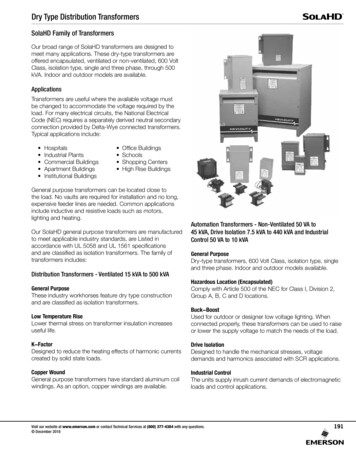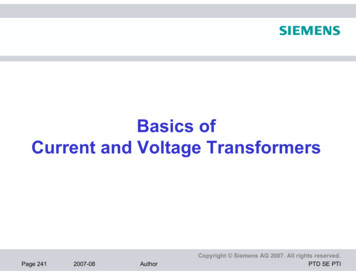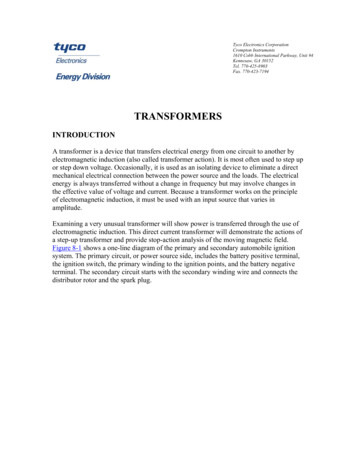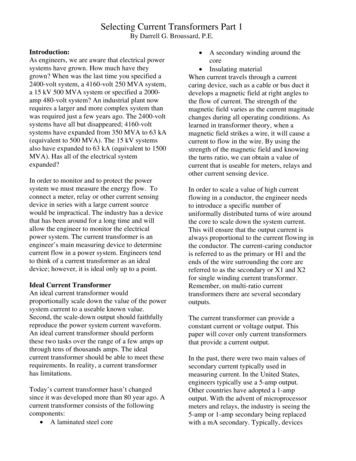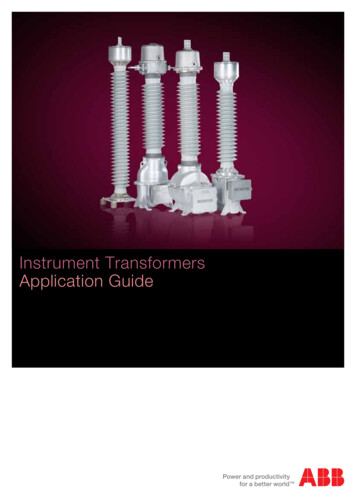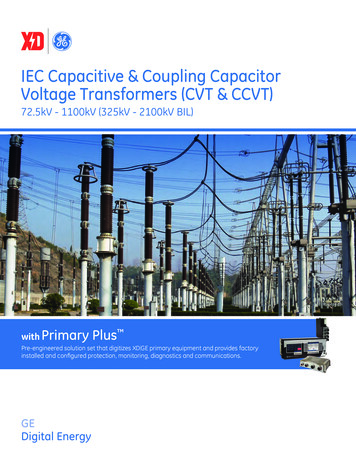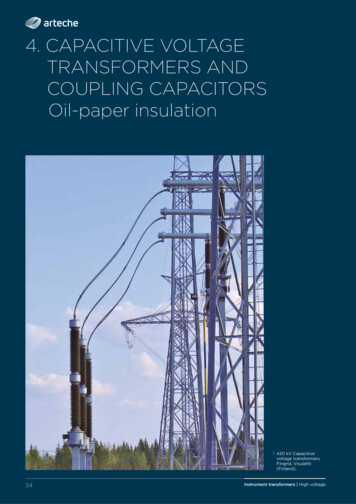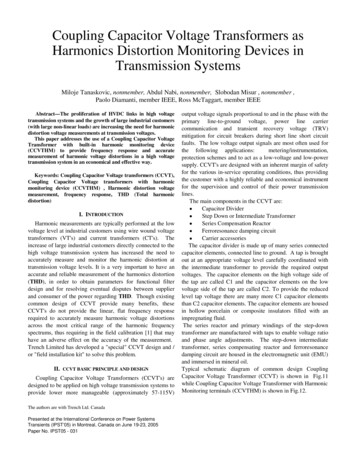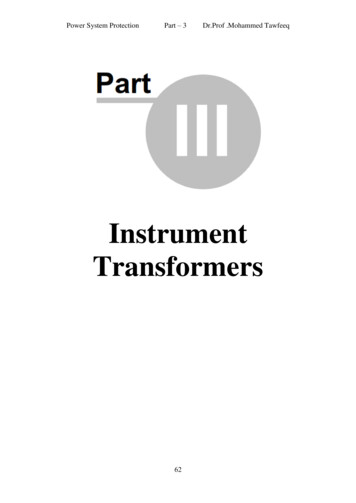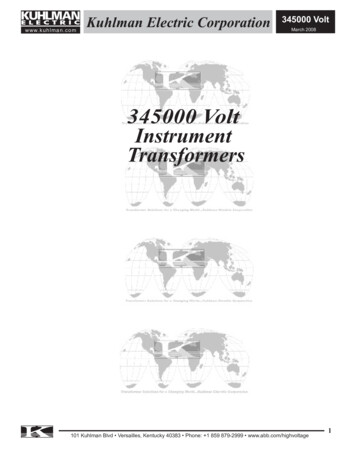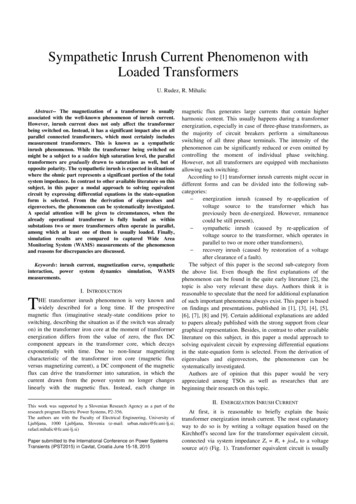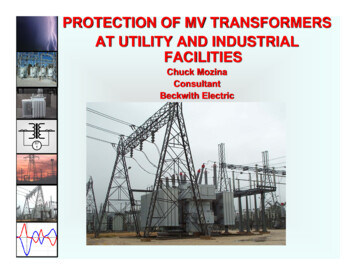
Transcription
PROTECTION OF MV TRANSFORMERSAT UTILITY AND INDUSTRIALFACILITIESChuck MozinaConsultantBeckwith Electric87T
Chuck Mozina -- is a Consultant, Protection and Protection Systems for BeckwithElectric and resides in Palm Harbor (near Tampa), Florida. His consulting practice involvesprojects relating to protective relay applications, protection system design and coordination. Hespecializes in generator and power plant protection.87TChuck is an active 25-year member of the IEEE Power System Relay Committee (PSRC) and isthe past chairman of the Rotating Machinery Subcommittee. He is active in the IEEE IASI&CPS, PCIC and PPIC committees, which address industrial system protection. He is a formerU.S. representative to the CIGRE Study Committee 34 on System Protection and has chaired aCIGRE working group on generator protection. He also chaired the IEEE task force thatproduced the tutorial “The Protection of Synchronous Generators,” which won the PSRC’s 1997Outstanding Working Group Award. Chuck is the 1993 recipient of the Power System RelayCommittee’s Career Service Award and he recently received the 2002 IAS I&CPS Ralph LeePrize Paper Award. His papers have been republished in the IAS Industrial ApplicationsMagazine.Chuck has a Bachelor of Science in Electrical Engineering from Purdue University and is agraduate of the eight month GE Power System Engineering Course. He has authored a numberof papers and magazine articles on protective relaying. He has over 25 years of experience as aprotection engineer at Centerior Energy, a major investor-owned utility in Cleveland, Ohio wherehe was the Manager of the System Protection Section. He spent 10 years as the ApplicationsManager for Relay Products for Beckwith Electric. He is also a former instructor in the GraduateSchool of Electrical Engineering at Cleveland State University as well as a registeredProfessional Engineer in the state of Ohio and a Life Fellow of the IEEE.
OUTLINE 87TIEEE PROTECTION STANDARDSWHY TRANSFORMERS FAILTRANSFORMER BASICSPHASING STANDARDS IEEE/ANSI IEC TRANSFORMER DIFFERNTIAL Phase (87T) Gnd (87GD) OVEREXCITATION PROTECTION DIGITAL TRANSFORMER RELAYS
IEEE Standards Latest developments reflected in:– Std. 242: Buff Book Transformer ProtectionChapter 1187T– ANSI / IEEEC37.91“Guide for ProtectiveRelay Applications for Power Transformers”These are created/maintained by the IEEE PSRC & IASThey are updated every 5 years
87TWHYTRANSFORMERSFAIL
What Fails in Transformers? Windings– Insulation deterioration from 87TMoistureOverheatingVibrationVoltage surgesMechanical Stress from through-faults LTCs––––Malfunction of mechanical switching mechanismHigh resistance contactsOverheatingContamination of insulating oil
What Fails in Transformers?HARTFORD STEAM BOILER INSPECTION & INSURANCE CO.Cause87T% of FailuresInsulation Failure26%Manufacturing Problems24%Unknown16%Loose Connections7%Through Faults5%Improper Maintenance5%Oil ing3%Floods2%Moisture1%
ThroughFaultCategory 35-30 MVA87T
ThroughFaultCategory 4Larger than30 MVA87T
87TTRANSFORMERPROTECTION BASICS
Transformer Formulas V1I1 V2I2 N1V2 N2V1 N1I1 N2I2Transformer FundamentalsI1 5I2 10AA87TN1 100V1 100N2 50V2 50Ideal Transformer – No Losses
INSULATION MATERIALS Dry- Used where liquid spills cannot be tolerated- Small ratings, lower voltage distribution87T Wet- Offers smaller size, lower cost and greateroverload capacity- Liquids have greater coefficient of heat transferthen dry insulation- Vast majority of power transformers use wet (oil)insulation.
Basic Transformer DesignsGas-Oil Sealed TransformersPressure ReliefRegulatingValveNI GASOIL87TFansGas RegulatorNI Gas TankTransformer RatingsOA/FA/FA
Basic Transformer DesignsConservator Tank SystemPressure ReliefBreather &ScreenOILConservatorTankOil LevelSump87TOILTransformer are Generally notForced CooledOil Drain
Basic Transformer DesignsShell & Core87T Core Form-Single path for themagnetic circuitLess Shell Form- Multiple paths for themagnetic circuit- Better through-faultwithstand
IEEE Devices used inTransformer Protection87T 24: Overexcitation (V/Hz)46: Negative Sequence Overcurrent49: Thermal Overload50: Instantaneous Phase Overcurrent50G: Instantaneous Ground Overcurrent50N: Instantaneous Neutral Overcurrent50BF: Breaker Failure51G: Ground Inverse Time Overcurrent51N: Neutral Inverse Time Overcurrent63: Sudden Pressure Relay (Buccholtz Relay)81U: Underfrequency87HS: High-set Phase Differential (Unrestrained)87T: Transformer Phase Differential with Restraints87GD: Ground Differential (also known as “restricted earth fault”)
BASIC UTILITY SOLIDLYGROUNDED TRANSFORMERPROTECTIONS87T87THigh SideLow Side51505151G
Basic Industrial TransformerProtection87TAux. CTHigh Side51Low Side87T505151GRESISTOR200-400 A87GD
Types of ProtectionMechanical Accumulated Gases– Arcing by-products87T Pressure Relays– Arcing causing pressure waves in oil or gasspace Thermal– Caused by overload, overexcitation, harmonicsand geo magnetically induced currents Hot spot temperature Top Oil LTC Overheating
Sudden Pressure Relay (SPR)ProtectionNI GasGASNiOIL87TSudden Pressure RelayTransformer
Transformer Thermal MonitoringNI GAS4987TWinding HotSpotTop OilTemp.49WOIL
Types of ProtectionFusesSmall transformers ( 10 MVA Solidly Grounded)Short circuit protection onlyOvercurrent ProtectionHigh side87TThrough fault protectionDifferential back-up protection for high side faultsLow sideSystem back up protectionDifferential ProtectionPhase Diff.Ground Diff.
DELTA-WYE TRANSFORMERSUNDER FAULT CONDITIONS1.01.00.5770.5771.01.00.577R1.01.0A) Three Phase Fault0.587T00.50.8660.5O.5R0.8661.0B) Phase to Phase Fault in pu of Three Phase Fault0.5771.00.5770.577R000C) Line to Ground Fault
DELTA-WYE TRANSFORMERSLIMITATIONS OF FUSING138KV13.8KV40A/1.73 23AF400A0.577F87TF40A/1.73 23A400A000Line to Ground Fault 10 MVA 138/13.8KVIFL 10,000/1.73 X 138 42AWHEN FUSES ARE SIZED TO CARRY LOADTHEY CAN’T DETECT A GROUND FAULT
87TTRANSFORMERPHASING STANDARDSIEEE/ANSI & IEC
ANSI/IEEE PHASING STANDARD H1, H2, H3– Primary BushingsX1, X2, X3– Secondary taDelta-WyeWye-DeltaH1 and X1 at zero degreesH1 and X1 at zero degreesH1 lead X1 by 30 degreesH1 lead X1 by 30 degrees
Angular Displacement - DevelopmentAH1X1aBH2X2bCH3X3cHVLV87TCAcab H1 (A) leads X1 (a)by 30 Currents on “H”bushings are deltaquantities Can Describe asDelta AB (Ia Ia-Ib)BAssume 1:1 transformer
Angular Displacement - TCAcab H1 (a) leads X1 (A)by 30 Currents on “X”bushings are deltaquantities Can Describe asDelta AC (Ia IA-IC)BAssume 1:1 transformer
Transformer Phasing – IECPhasing StandardEuro-designations use 30 increments of LAGfrom the X1 bushing to the H1 bushings01187T12109384765
87T Transformer PhasingCommunicating Phasing To DigitalRelaysMajor Source of Setting ErrorIEEE-ANSI – Can use AB or ACIEC – Need to Use 30o ClockCT’s Can be or YSolution: Let the Software Decide
AngularDisplacement*1*1*2 87T*2 IEC (Euro) practice does nothave a standard like ANSIMost common connection isDy11 (low lead high by 30!)Obviously observation ofangular displacement isextremely important whenparalleling transformers!*1 ANSI std. @ 0 *2 ANSI std. @ X1 lag H1 by 30 ,or “high lead low by 30 “
Winding Arrangements Wye-Wye– Conduct zero-sequence between circuits– Provides ground source for secondary circuit Delta-Delta87T– Blocks zero-sequence between circuits– Does not provide a ground source Delta-Wye– Blocks zero-sequence between circuits– Provides ground source for secondary circuit Wye-Delta– Blocks zero-sequence between circuits– Does not provide a ground source for secondary circuit
87TTRANSFORMERDIFFERENTIALPROTECTION
Types of ProtectionElectrical Phase Differential87T– Applied with variable percentage slopes toaccommodate CT saturation and CT ratio errors– Applied with inrush and overexcitation restraints– Set with at least a 15% pick up to accommodateCT performance Class “C” CT; 10% at 20X rated– If unit is LTC, add another 10%– May not be sensitive enough for all faults (lowlevel, ground faults near neutral, resistorgrounded transformers )
Basic Differential RelayTRANSFORMER87TRELAYOperateRestraint W-1TAP W-1Restraint W-2TAP W-2
Basic Differential RelayExternal FaultTRANSFORMER87TRELAYOperate 0Restraint W-1TAP W-1Restraint W-2TAP W-2
Basic Differential RelayInternal FaultTRANSFORMER87TRELAYOperateRestraint W-1TAP W-1Restraint W-2TAP W-2
TypicalPhase DifferentialCharacteristic –Percentage SlopeConcept87TI1 I2 I3 0I1UNITI3I2
Unique Issues Applying toTransformer Differential Protection87T CT ratio caused current mismatch Transformation ratio caused currentmismatch (fixed taps) LTC induced current mismatch Delta-wye transformation of currents– Vector group and current derivation issues Zero-sequence current elimination forexternal ground faults on wye windings Inrush phenomena and its resultantcurrent mismatch
Classical Differential Compensation CT ratios must be selected toaccount for:87T– Transformer ratios– If delta or wye connected CTs areapplied– Delta increases ratio by 1.73 Delta CTs must be used to filter zerosequence current on wye transformerwindings
Unique Issues Applying toTransformer Differential Protection87T Harmonic content availability during inrushperiod due to point-on-wave switching(especially with newer transformers) Overexcitation phenomena and itsresultant current mismatch Internal ground fault sensitivity concerns Switch onto fault concerns CT saturation, remnance and tolerance
Classical Electro-MechanicalDifferential Compensation87T
Digital Relay Application87T
Compensation in Digital Relays Transformer ratio CT ratio Vector quantities87T– Which vectors are used– Where the 1.73 factor ( 3) is applied When examining line to line quantities on deltaconnected transformer windings and CT windings Zero-sequence current filtering for wyewindings so the differential quantities donot occur from external ground faults
Digital Relay Application87TAll wye CTs shown, can retrofit legacy delta CT applications
Benefits of Wye CTs Phase segregated line currents87T– Individual line current oscillography– Currents may be easily used forovercurrent protection and metering– Easier to commission and troubleshoot– Zero sequence elimination performed bycalculation– BUT IS IT WORTH ALL THE RE-WIRINGIN RETRO-FIT APPICATIONS ?
Typical ApplicationsM-331087TREF Twowindingtransformer,with NeutralInput
Typical Applications87TREFREF Main-Tie-Main Substation
TypicalApplications87T Generator unitdifferentialwrap
Inrush Restraint87T
Advanced Element Design: 87T Inrush Detection and Restraint87T– 2nd harmonic restraint has been employed foryears– “Gap” detection has also been employed– As transformers are designed to closertolerances, both 2nd harmonic and low currentgaps in waveform have decreased– If 2nd harmonic restraint level is set too low,differential element may be blocked for internalfaults with CT saturation (with associatedharmonics generated)
Advanced Element Design: 87T Inrush Detection and Restraint87T– 4th harmonic is also generated during inrush– Odd harmonics are not as prevalent as Evenharmonics during inrush– Odd harmonics more prevalent during CTsaturation– Use 4th harmonic and 2nd harmonic together– M-3310/M-3311 relays use RMS sum of the 2ndand 4th harmonic as inrush restraint– Result: Improved security while not sacrificingreliability
Advanced Element Design: 87T87T2nd and 4thHarmonicsDuringInrushTypical Transformer Inrush Waveform
Cross Phase Averaging87T Provides security if any phase haslow harmonic content during inrush oroverexcitation This can occur depending on thevoltage point-on-wave when thetransformer is energized for a givenphase Cross phase averaging uses theaverage of harmonics on all threephases to determine level
Advanced Element Design: 87T87T Overexcitation Restraint– Overexcitation occurs when volts per hertz levelrises (V/Hz)– This typically occurs from load rejection andmalfunctioning generation AVRs– The voltage rise at nominal frequency causes theV/Hz to rise– This causes 5th harmonics to be generated in thetransformer as it begins to go into saturation– The current entering the transformer is more thanthe current leaving due to this increase inmagnetizing current– This causes the differential element to pick-up– Use 5th harmonic level to detect overexcitation
Advanced Element Design: 87T Overexcitation Restraint87T– Most other relays block the differential elementfrom functioning during transformeroverexcitation– M-3310/M-3311 do not block it, but rather raisethe pick up level to accommodate the differencecurrents caused by the transformer saturation– This allows the differential element to trip if aninternal fault occurs during the overexcitationperiod due to increased stress level on theinsulation– Result: Improved reliability while not sacrificingsecurity
Trip Characteristic – 87T87T
Trip Characteristic – 87T 87T Pick Up–––––87TClass C CTs, use 10%5% MarginLTC, add 10%Magnetizing losses, add 1%0.15 to 0.3 pu typically setting Slope 1– Used for low level currents– Can be set as low as 15%– With LTC 25-30% Slope 2 “breakpoint”– Typically set at 2X rated current– This setting assumes that any current over 2X rated is athrough fault or internal fault, and is used to desensitizethe element against unfaithful replication
Trip Characteristic – 87T Slope 2– Typically set at 60% (double slope 1) Inrush Restraint (2nd and 4th harmonic)87T– Typically set from 10-15%– Employ cross phase averaging blocking forsecurity– Blocks tripping for 10 cycles Overexcitation Restraint (5th harmonic)– Typically set at 30%– Raise 87T pick up by 200% or 0.60 pu duringoverexcitation– No cross phase averaging needed, asoverexcitation is symmetric on the phases
Trip Characteristic – 87H 87H Pick Up87T– Typically set at 10pu rated current– This value should be above maximum possibleinrush current and lower than the CT saturationcurrent– C37.91, section 5.2.3, states 10pu anacceptable value– Can use data captured from energizations tofine tune the setting
CT Issues87T Remnance: Residual magnetism thatcauses dc saturation of the CTs Saturation: Error signal resulting from toohigh a primary current combined with a largeburden Tolerance: Class “C” CTs are rated 10% forcurrents x20 of nominal– Thru-faults and internal faults may reach thoselevels depending on ratio selected
IS THE CT GOOD ENOUGH ? Provides security for high fault current levels outside thedifferential zone where CT inputs can saturate. Factors effecting CT saturation- Residual magnetism in CT core- CT characteristic mismatch- CT circuit burden87T CT Burden Check– want to operate below the knee-pointvoltage (Vk) for worst-case fault external to diff. Zone.VS IP [RCT RW RR]NWhere IP is the maximumexternal fault currentIex – Excitation Current
CT Issues Best defense is to use high “Class C”voltage levels– C200,C400, C800– These have superior characteristics againstsaturation and relay/wiring burden87T Use low burden relays– Digital systems are typically 0.020 ohms Use a variable percentage slopecharacteristic to desensitize the differentialelement when challenged by high currentsthat may cause replication errors
Improved Ground Fault SensitivityGround Differential Protection (87GD)87T 87T element is typically set with 15-30%pick up This is to accommodate Class “C” CTaccuracy during a fault plus the effectsof LTCs That leaves 10-15% of the winding notcovered for a ground fault (SolidlyGrounded Winding) When a neutral resistor limits groundcurrent to 200-400A no ground faultprotection is provided for that winding bythe 87T element. Employ a ground differential element toimprove sensitivity (87GD)
Differential SensitivityReduced for Ground FaultNear the Neutral87T
Improved Ground Fault Sensitivity138KV40A/1.73*40/1 0.58A200/540A/1.7345 MVA400AI 0R 400A87T87TTypical Pickup of 87T: O.3 pu pickup Relay Tap set atTrans. Rating(45MVA)IFL138KV 4.71Amps PU 4.71A x 0.3 1.41AOpen2000/513.8KV WITHOUT GROUND DIFF. (87GD) THERE IS NOHIGHSPEED PROTECTION FOR SEC. GND FAULTS
Improved Ground Fault Sensitivity87T87T
Trip Characteristic – 87GD 87GD Pick Up– Element normally uses directional comparisonbetween phase residual current (3I0) andmeasured ground current (IG) No user setting87T– Pick up only applicable when 3I0 current isbelow 140mA (5A nom.) Pick up 3I0 - IG– If 3I0 greater than 140mA, element uses: –3I0 * IG * cosθ. It will trip only when the directionsof the currents is opposite, indicating an internal fault Using direction comparison mitigates the effects ofsaturation on the phase and ground CTs
Trip Characteristic – 87GDIAIBResidual currentcalculated fromindividual phasecurrents. ParalleledCTs shown toillustrate principle.IC87TIGIG903 I03I O0180-3Io x IG cos (180) 3IoIGIG270
Trip Characteristic – 87GDIAIBResidual currentcalculated fromindividual phasecurrents. ParalleledCTs shown toillustrate principle.IC9087TIGIG3I 0180-3Io x IG cos (0) -3IoIG0IG3I O 270
87TTRANSFORMEROVEREXCITATIONPROTECTION
Transformer Limits Overexcitation– Responds to overfluxing; excessive V/Hz– Continuous operational limits ANSI C37.91 & C57.1287T– 1.05 loaded, 1.10 unloaded– Measured at the transformer output Inverse curves typically available for valuesover the continuous allowable maximum Protection required application of V/Hz (24)protection
Overexcitation/Volts per Hertz (24)87TPHYSICAL INSIGHTS As voltage rises above rating leakage flux increases Leakage flux induces current in transformer supportstructure causing rapid localized heating
Industrial System OverexcitationPower SystemHigh Voltage During MajorSystem Disturbance87TPlant Separated ontoLocal Plant Gen.TransformersStill Connectedto Power SystemEven After LoadTransfered ontoPlant Generation
Overexcitation Event on EHVTransmission ENCLOSEDC DISTRIBUTED LINECAPACITANCESHUNT REACTOR DISCONNECTSWITCH INADVERTENTLY LEFT OPENFig. 11 Overexcitation Failure of an EHV Autotransformer
Overexcitation Curve87TThis is typically how the apparatus manufacturer specs it
Overexcitation Digital Relay Curve87T
V/Hz Event87T
VA & IA87TGEN. BREAKER OPENALARMALARMTRIP
IA87TGEN. BREAKER OPENALARMALARMTRIP
87TDIGITAL RELAYTRANSFORMERPROTECTION
Digital Transformer Relays87T
Digital Relay Features Self-Monitoring and Diagnostics. Some Monitoring of VT and CTInputs. Multiple Input and Output Contacts87T Multiple Setting Groups Programmable Logic Metering of all Inputs Oscillography and Event Recording Communications
Two Winding TransformerRelay-- External Connections 2 Three Phase Current, plus 1 Ground Current Input 3 Phase and One Ground Voltage Input
Three Winding TransformerRelay-- External Connections 3 Three Phase Current, plus Two Ground Current Inputs! One Voltage Input
Four Winding TransformerRelay-- External Connections87T 4 Three Phase Current, plus 3 Ground CurrentInputs! Two Voltage Input
This function is available as as tandard protective function.CTThis function is available as aoptional protectivefunction.AM-3310 Transformer Protection (Optional)Integral eringSequence OfEventsVTWaveformCaptureIRIG-B2481U27Front RS-232CommunicationBRear BECO 2200or MODBUSCommunicatio
I&CPS, PCIC and PPIC committees, which address industrial system protection. He is a former U.S. representative to the CIGRE Study Committee 34 on System Protection and has chaired a CIGRE working group on gener
